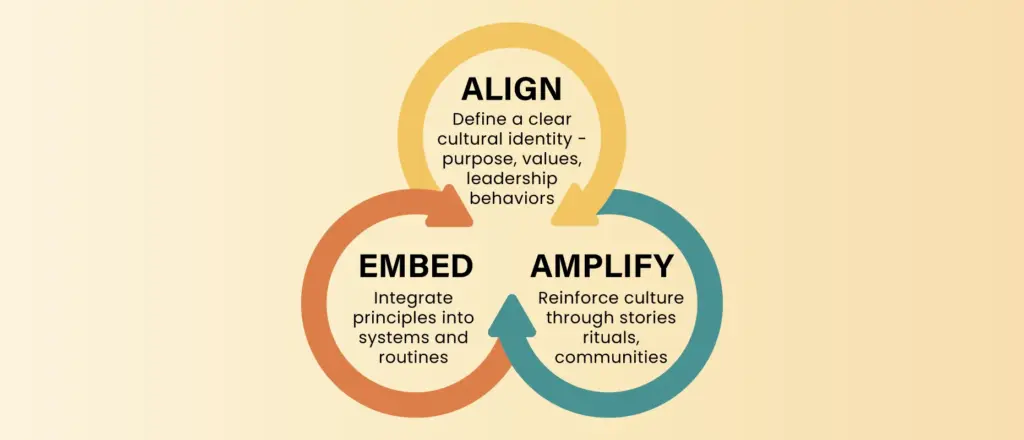Walk into any modern workplace today and you’ll find culture on display — flexible hours, open seating, mindfulness sessions, and cheerful Friday socials. These gestures signal care and progress. Yet, behind the vibrant posters and relaxed policies, many organisations quietly wrestle with disengagement, trust deficits, and attrition.
The truth? Perks can attract talent, and policies can retain them for a while — but neither can build genuine culture.
Real culture doesn’t live in employee handbooks or company slogans. It lives in the everyday rhythm of work — how people speak in meetings, how feedback is received, how leaders behave under pressure, and how decisions are made when no one is watching. It’s invisible, but it drives everything.
The Illusion of a “Good Culture”
For years, organisations have mistaken benefits for belonging. A stocked pantry, a “work from anywhere” policy, or an annual offsite can boost morale, but they rarely build commitment.
A 2024 PwC study found that while 80% of leaders call culture “critical to performance,” fewer than 30% have integrated it into their business strategy. That gap between what’s promised and what’s practiced is where many cultures falter.
Atlassian provides a well-known example, having introduced ‘No Meeting Wednesdays’ to improve focus and promote work-life balance. While the intent was progressive, many teams later reported that productivity gains depended more on behavioural change than policy itself. The lesson echoed across global firms — removing meetings doesn’t fix the deeper issues of trust, ownership, and accountability. Within months, employees were still working late — only now spending Fridays buried in backlogs. The initiative was progressive in intent but failed in practice because the underlying behaviours — trust, ownership, and accountability — never changed.
Culture, in essence, is not what’s written in memos; it’s what people feel every day.
Setting the Context
In the Culture First podcast, workplace expert Amy Gallo offers a compelling perspective:
“Most teams confuse the absence of conflict with a healthy culture.”
Her point resonates deeply. When companies prioritise harmony over honesty, innovation suffers. True culture isn’t about comfort — it’s about creating psychological safety where difficult conversations lead to better outcomes.
In the Better by Great Place to Work podcast, Harit Nagpal, MD & CEO of Tata Play, shared how transparency—not perks—became their cultural turning point. By candidly discussing business realities and leadership lessons, Tata Play replaced silence with trust and strengthened employee ownership. These stories remind us that culture is not about what leaders give their teams; it’s about how they show up for them.
What Actually Shapes Workplace Culture
Every organisation has a culture — the question is whether it’s intentional or accidental. Across industries, four forces consistently define how culture takes root and grows:
- Leadership Behaviour
Employees don’t look to policy documents to decide how to act — they look at their leaders. A leader’s tone during crises, their response to mistakes, and their consistency under pressure set the real standard. - Shared Beliefs and Purpose
When people understand why their work matters, they align naturally. Shared purpose connects individuals to something larger than their roles, fostering meaning and motivation. - Everyday Interactions
Culture isn’t built in town halls; it’s built in micro-moments — how feedback is delivered, how credit is shared, and how conflicts are resolved. These daily interactions silently teach employees what the organisation truly values.
Today, this looks very different depending on where people work. The sense of connection that comes from being physically present in an office — spontaneous conversations, shared energy, and informal learning — cannot be fully replicated online. While remote work offers flexibility, in-person environments often provide a deeper sense of belonging and immediacy that shapes how teams bond and behave. - Consistency Between Words and Actions
Nothing destroys trust faster than inconsistency. If collaboration is celebrated publicly but competition is rewarded privately, cynicism sets in. When words and actions align, trust compounds.
A Story of Culture in Practice
A growing digital firm in India, much like Zoho or Zerodha, faced a similar challenge. Their engagement scores were strong, but attrition was rising. Exit interviews revealed a common theme: employees didn’t feel heard.
The leadership team resisted the temptation to add new perks. Instead, they looked inward — focusing on behavioural shifts rather than benefits. Managers began hosting open conversations instead of formal reviews. Recognition became peer-led, not top-down. Transparency replaced silence.
Within six months, voluntary attrition dropped by more than a third. Employees described feeling part of a “living culture” — one that listened, adapted, and evolved.
The change didn’t come from a new policy. It came from consistency, empathy, and action.
Building Culture by Design, Not Default
Creating a strong workplace culture isn’t about programs or slogans — it’s about design. The most resilient organisations build culture intentionally through three essential steps:

- Align: Define a clear cultural identity — purpose, values, and leadership behaviours that reflect the company’s ethos.
- Embed: Integrate these principles into systems and routines — from hiring and performance to recognition and communications.
- Amplify: Reinforce culture through stories, rituals, and communities that keep it alive as the organisation grows.
When culture is aligned, embedded, and amplified, it stops being an HR topic — it becomes a strategic advantage.
The Leadership Reflection
Culture doesn’t fail because people don’t care; it fails because leaders assume it will take care of itself. The best leaders know culture isn’t an announcement — it’s a reflection of their everyday choices.
As you think about your own organisation, ask:
- Do our systems reward the behaviours we say we value?
- Do our teams feel safe to share their truth?
- Are we designing culture intentionally, or letting it drift by default?
The answers to these questions often reveal more about your culture than any engagement survey can.
Conclusion: From Aesthetic to Authentic
The workplaces of tomorrow won’t be defined by aesthetics but by authenticity.
Perks can delight; policies can structure. But only trust, purpose, and consistency can sustain.
Because in the end, culture isn’t built by what you offer your people — it’s built by how you make them feel every single day.
The organisations that will thrive are those that see culture not as decoration, but as DNA — a living system that connects belief with behaviour, and people with purpose.
